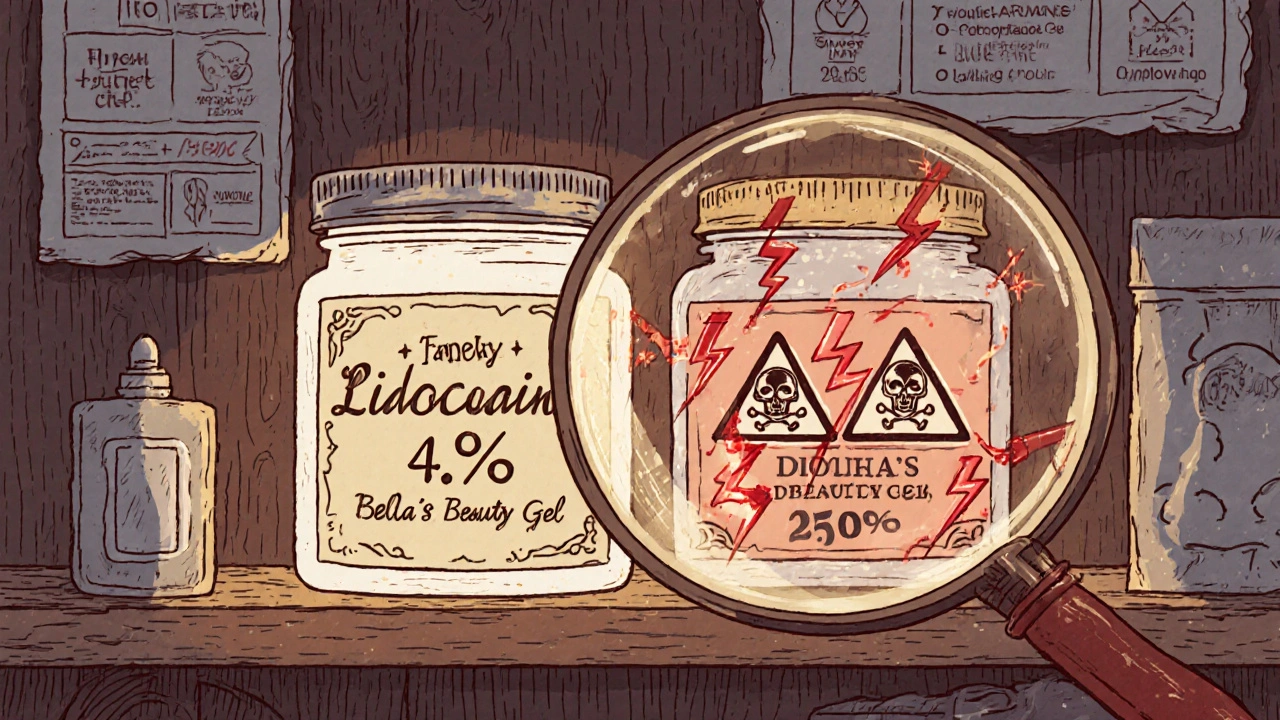What Are OTC Topical Pain Relievers?
OTC topical pain relievers are creams, gels, and patches you can buy without a prescription to ease muscle aches, joint stiffness, or arthritis pain right where it hurts. Unlike pills that travel through your whole body, these products work locally-delivering pain relief directly to the skin. They’re popular because they avoid stomach upset, liver stress, or kidney risks tied to oral NSAIDs like ibuprofen. But just because they’re over-the-counter doesn’t mean they’re risk-free.
Common Ingredients and How They Work
Not all topical pain relievers are the same. Their effectiveness and safety depend on what’s in them.
- Menthol (usually 10% in products like Aspercreme Heat Gel) creates a cooling sensation that tricks nerves into feeling less pain. It’s common in gels and roll-ons.
- Capsaicin (0.025% to 0.1%) comes from chili peppers. It depletes substance P, a chemical that sends pain signals. It takes days to work and must be applied 3-4 times daily.
- Methyl salicylate is related to aspirin. It reduces inflammation and warms the skin. Found in patches and rubs.
- Lidocaine is a numbing agent. OTC products are legally limited to 4%. Anything higher is illegal and dangerous.
- Diclofenac is an NSAID in gel form (like Voltaren). It’s absorbed through the skin and reduces inflammation locally.
Each ingredient has different risks. Menthol can cause burns. Lidocaine above 4% can trigger heart problems. Capsaicin doesn’t cause burns but can irritate eyes if you touch your face after applying it.
The Hidden Danger: Menthol Skin Burns
In 2017, Health Canada reviewed over 20 years of data and found a clear link between menthol-containing topical pain relievers and rare but serious skin burns. These weren’t minor redness-they were second-degree burns requiring medical care. The burns happened even when people followed instructions. No such link was found for capsaicin or methyl salicylate alone.
Since then, Canadian regulations require all menthol products to carry a warning label about burn risk. The U.S. FDA hasn’t mandated the same label, but doctors and pharmacists now routinely warn patients. If you use a menthol gel and feel intense cold, tingling, or stinging that doesn’t fade, stop using it. Don’t apply it before or after a hot shower, sauna, or heating pad. Heat increases absorption-and risk.
Lidocaine: The Illegal Product Problem
In July 2023, the FDA issued a public warning about illegal topical pain products sold online and in beauty supply stores. Brands like Bella’s Beauty Supply, DermaWand, and DermaFlash were selling gels and sprays with lidocaine concentrations up to 20%-five times the legal limit.
These products were marketed for use during cosmetic procedures: laser hair removal, tattoos, microdermabrasion. But when applied to freshly treated skin, the body absorbs too much lidocaine. That can lead to seizures, irregular heartbeat, and trouble breathing. The FDA tested samples and confirmed the high doses. They’ve issued warning letters and seized inventory. Still, these products keep popping up on Amazon, Etsy, and Instagram ads.
Always check the ingredient label. If it says “lidocaine” and doesn’t list the percentage, or if the concentration is higher than 4%, don’t use it. If you bought a product from a small online shop with no clear manufacturer info, assume it’s unsafe.

Who Should Avoid These Products?
Some people are at higher risk, even with proper use.
- People with salicylate sensitivity (like those allergic to aspirin) should avoid methyl salicylate and diclofenac.
- Those on blood thinners (warfarin, rivaroxaban) should talk to their doctor before using diclofenac or methyl salicylate-these can increase bleeding risk.
- People with open wounds, rashes, or sunburned skin should never apply any topical pain reliever. The skin is more permeable, increasing absorption and side effects.
- Pregnant women should avoid diclofenac and high-dose capsaicin unless approved by a provider.
- Children under 12 should not use capsaicin or menthol products unless directed by a pediatrician.
How to Use Them Safely
Even safe products can cause harm if misused. Follow these steps:
- Read the label. Know the active ingredient and concentration.
- Apply only to healthy, intact skin. No cuts, scrapes, or sunburns.
- Wash your hands right after applying-especially with capsaicin or menthol.
- Use gloves or a roll-on applicator for capsaicin. Don’t touch your eyes, nose, or mouth.
- Never combine with heat. No heating pads, hot tubs, or electric blankets after application.
- Don’t cover with bandages unless the product instructions say to.
- Wait at least 30 minutes before showering or swimming.
- Stop if you feel burning, itching, or redness that lasts more than a few minutes.
How Long Do They Take to Work?
Don’t expect instant results. Menthol and methyl salicylate often relieve pain within minutes. But capsaicin and diclofenac can take up to 7 days to show real improvement. If you stop using capsaicin after a few days because it doesn’t work, you’re missing the point. It needs daily use for a week or more to build up effectiveness.
Also, tolerance can develop. If a product that used to help no longer works after weeks of daily use, it may be time to switch or take a break. Continuous use without breaks can reduce effectiveness.

Topical vs. Oral Pain Relievers: Safety Comparison
Oral NSAIDs like ibuprofen and naproxen carry well-documented risks: stomach bleeding (1-2% of regular users), kidney damage, high blood pressure, and heart strain. Topical versions avoid most of these because only a small amount enters the bloodstream.
Harvard Health found that topical diclofenac and capsaicin deliver less than 10% of the systemic dose compared to taking a pill. That’s why they’re often recommended for older adults or people with kidney issues. But that doesn’t mean they’re harmless. Overuse or misuse still leads to skin reactions, nerve irritation, or accidental poisoning-especially in kids who touch the product and then their eyes.
When to See a Doctor
Topical pain relievers are great for short-term relief of minor aches. But if your pain lasts more than 7 days, gets worse, or spreads beyond the area you applied it to, see a doctor. Same if you develop a rash, blistering, or numbness that doesn’t go away.
Also, if you’re using these products regularly for chronic pain (like osteoarthritis), talk to your provider. There may be better long-term options-physical therapy, weight management, or prescription treatments-that reduce your need for daily topical use.
What’s Next for Safety?
Regulators are watching. Health Canada’s 2017 label update set a global standard. The FDA’s 2023 crackdown on illegal lidocaine products shows they’re not ignoring the problem. But consumer education is still lagging. Many people assume “natural” or “OTC” means “safe for anything.”
Future improvements will likely include:
- More standardized warning labels across North America
- Clearer packaging that distinguishes OTC from prescription-strength versions
- Stronger enforcement against online sellers of illegal products
- Public awareness campaigns about menthol burn risks and lidocaine dangers
For now, your best protection is knowledge. Know what’s in the product. Know how to use it. Know when to stop.
Can topical pain relievers cause serious burns?
Yes-specifically products containing menthol. Health Canada confirmed in 2017 that menthol can cause rare but serious second-degree skin burns, even when used correctly. No such link exists for capsaicin or methyl salicylate alone. Always check the label and avoid heat sources after application.
Is lidocaine in OTC pain patches safe?
Only if the lidocaine concentration is 4% or less. Products with higher levels (up to 20%) are illegal and dangerous. They’ve been linked to seizures, irregular heartbeat, and breathing problems, especially when used on broken or freshly treated skin. Always check the label and avoid products from unknown online sellers.
Can I use capsaicin cream if I have sensitive skin?
Use caution. Capsaicin causes a burning sensation when first applied, which usually fades with continued use. But if your skin is already irritated, sunburned, or broken, don’t use it. Always wear gloves or use a roll-on applicator, and wash your hands thoroughly afterward to avoid accidentally touching your eyes.
Do topical pain relievers interact with blood thinners?
Yes. Products containing methyl salicylate or diclofenac can increase bleeding risk when used with blood thinners like warfarin or rivaroxaban. While systemic absorption is low, the risk isn’t zero. Talk to your doctor or pharmacist before using these if you’re on anticoagulants.
How long should I use a topical pain reliever before seeing a doctor?
If your pain hasn’t improved after 7 days, or if it gets worse, spreads, or is accompanied by swelling or numbness, see a doctor. Topical pain relievers are meant for short-term relief of minor aches, not chronic or unexplained pain. Persistent pain may signal a deeper issue that needs diagnosis.
Can children use OTC topical pain relievers?
Most manufacturers advise against use in children under 12. Menthol and capsaicin can cause severe irritation in young skin. Even small amounts absorbed through thin skin can be harmful. Always check the label and consult a pediatrician before using any topical pain product on a child.

Chrisna Bronkhorst
November 10, 2025 AT 22:11Also why is everyone still buying those sketchy DermaFlash patches off Etsy? I've seen them in my feed. 18% lidocaine. That's not a cream, that's a chemical weapon.
Amie Wilde
November 11, 2025 AT 23:42Gary Hattis
November 12, 2025 AT 00:43My abuela used tiger balm back in the 80s and never had a problem. But now? We got influencers slapping 20% lidocaine on their ankles before laser hair removal and calling it 'self-care'.
It's not just about the product. It's about the culture that lets this stuff fly under the radar.
Esperanza Decor
November 13, 2025 AT 08:52Also, if your pain lasts more than a week? Go see someone. Topical painkillers aren't a bandaid for ignoring your body. They're a tool. Use it right.
Deepa Lakshminarasimhan
November 14, 2025 AT 06:21Erica Cruz
November 14, 2025 AT 21:52Johnson Abraham
November 16, 2025 AT 04:52Shante Ajadeen
November 16, 2025 AT 11:11dace yates
November 17, 2025 AT 08:59Danae Miley
November 19, 2025 AT 02:33Charles Lewis
November 19, 2025 AT 19:20Renee Ruth
November 21, 2025 AT 17:14Samantha Wade
November 22, 2025 AT 15:01